
Ancient Warriors – painting by Arturas Slapsys
Some of the very first things that interested me in history as a young boy were weapons and armour.
Boys will be boys, and so it’s no surprise that this is what drew me into the ancient and medieval worlds in the first place.
I remember getting a used book called The Art of Chivalry, which I flipped through over and over again. I was mesmerized by the images of broad swords and gothic armour, the shields, the lines, and the hack marks from various battles.
If there is one piece that has been common to most ancient cultures, it’s the helmet.
Apart from Celtic warrior heroes, most soldiers and fighters wore a helmet into battle. However, despite the common usage of something to protect the head and face, the styles varied greatly over the ages, making for some magnificent pieces that were utilitarian and beautiful at the same time.
So, here is my Top 10 list of favourite ancient and medieval battle helmets…
The Trojan War
#10 – Mycenaean Boar’s Tusk Helmet

My tenth choice on this list is one that you might not have expected to see. It isn’t made of iron or bronze, but rather of boar’s tusks that would have been sewn together over a skull-cap, or lining of some sort.
We’ve all heard about the Trojan War, but the portrayals of Greeks and Trojans wearing Classical Age Corinthian Helmets is not exactly accurate. We’re talking about the (approximately) 12th century B.C. here. This is a helmet of great antiquity that was worn by the heroes who fought beneath the walls of Troy in this most famous of wars.
I’ve put it on this list for sheer interest’s sake.
See You in the Lists!
#9 – Jousting Helmet
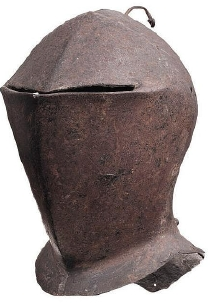
If gladiators were the entertainment of the Roman world, jousting was the equivalent of the Middle Ages.
From the time I was a boy, this is what I was drawn to. Two knights in armour careening toward each other with their lances couched. I could see their horses’ trappings fluttering as they came closer and closer and then the tremendous impact of splintered lances and shattered shields.
Fantastic! But wow, so dangerous. Tourney knights may have donned colourful ribbons and head dresses for the tilt, but they were certainly not wussies. These guys were tough as nails!
And they did this with little to no visibility! The tourney helms were thick and heavy, and were intended to deflect a lance point at speed. It must have been absolutely suffocating inside one of those.
But how imposing they looked, how fantastic with the colourful tourney crests affixed on the top. These guys took the tourney circuit, and the ladies, by storm, all in a chivalrous way, or course. Men such as William Marshall or Ulrich von Lichtenstein (not Heath Ledger, the real one!), made a name for themselves in the European lists and helped to shape the chivalric ideals we see in art and story.
Riding with Alexander the Great
#8 – Hellenistic Cavalry Helmet
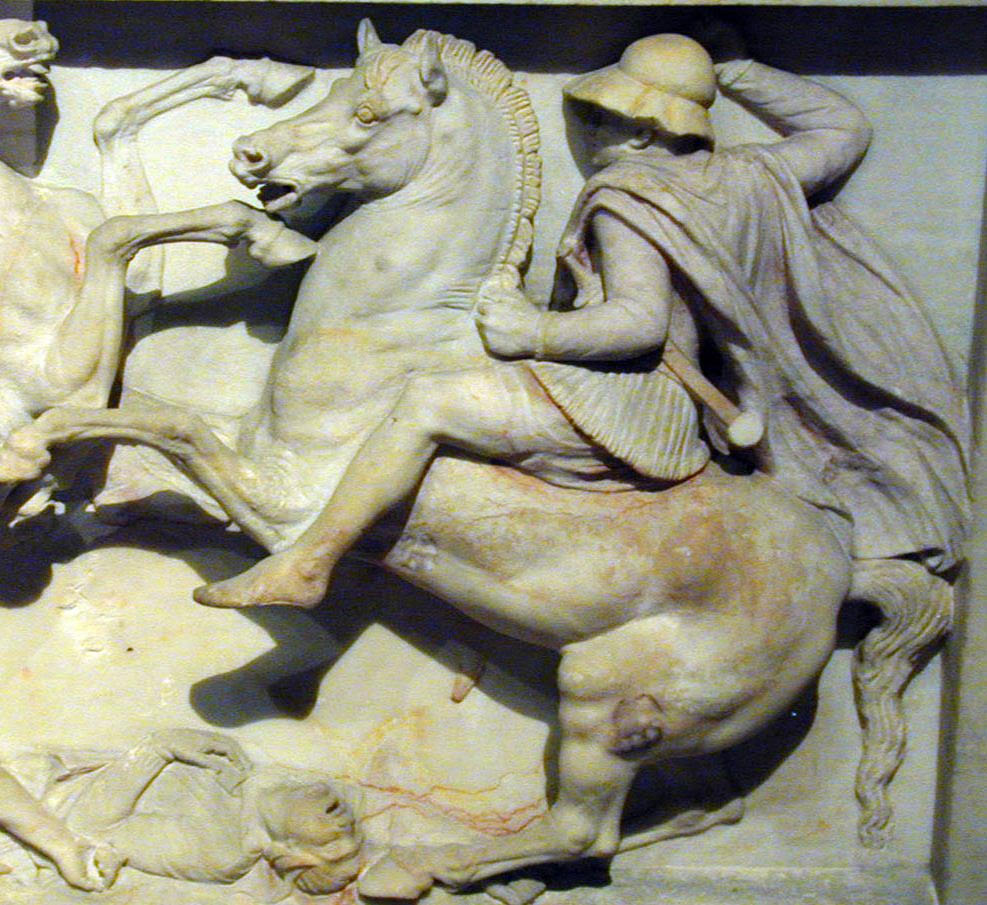
When you get to the time of Alexander the Great and the successors, they begin to add a bit more pizazz to their headgear. Alexander would have had special helmets outfitted just for him, perhaps made to look like a lion head which you can see on the coins (remember, the Argead dynasty claimed descent from Herakles!), or the ram horns of Zeus-Ammon.
My eighth pick would be the helmet commonly used by the Alexander’s Companion Cavalry, commonly thought to be the best cavalry in the ancient world. Being one of these guys was glamorous and carried a lot of cache. They wore a Boeotian-type cavalry helmet with embellishments such as laurels and other ornamentations. It was also a sort of armoured sun-hat, perfect for charging across the plains of Asia in summer.
But don’t let the fanciness fool you, the Companions were crack heavy cavalry troops, and fierce enough to help Alexander bring down the mighty Persian Empire.
The Battle of Hastings
#7 – Norman Conical Helmet
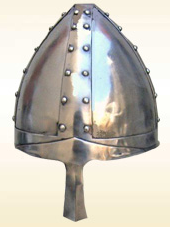
1066 is a year that many of you will be familiar with. This is the year that William the Conqueror and his Norman army invaded England and killed the last Saxon King, Harold, at the Battle of Hastings. The Normans changed the face of England, some might say not for the best.
But they were a fighting force to be reckoned with. And their arms and armour reflect a more functional, militaristic culture that is immortalized in the Bayeux Tapestry.
When I think of the Normans, I think of kite shields, chain mail, and of course the conical helmet. This may not be the most dashing or even protective of warlike head gear, but its silhouette is unmistakably Norman. It was basically two bits of steel held together by a spine with a big nose guard. That’s it. There was no neck protection unless chain mail was attached to the lower rim, and the face was exposed apart from the nose. It would have had great visibility and some deflective traits because of its pointed shape. It would not be my pick for personal use, but I’ve included it because there’s just something about it.
Gods of the Arena
#6 – Murmillo Gladiator

The Romans didn’t just like violence on the battlefield. They also enjoyed it on a Saturday afternoon, just for fun!
Some of the most enduring images of ancient Rome that we have are of gladiatorial combat in the amphitheatre. Gladiators were slaves, but they were also showman, and some reached unprecedented heights of popularity, almost as high as the charioteers of Rome.
Because it was a show, the gladiators played the roles of mythological beasts or ferocious, long-defeated enemies from past campaigns. But they didn’t wear masks, they wore elaborate helmets. My favourite gladiatorial helmet is the Murmillo, which was meant to represent a sort of sea creature, paired off against a Thracian warrior, or Thraex.
The Murmillo helmet was big and could be very elaborate with mythological or battle scenes embossed on it. This was an ornate, but heavy-duty helmet that was meant to inspire awe and take some heavy hits. During the early Empire, the Murmillo and Thraex were the most common pairing in combat. When they clashed, you can bet the crowd was baying for blood!
The Cross the the Crescent
#5 – Medieval Great Helm
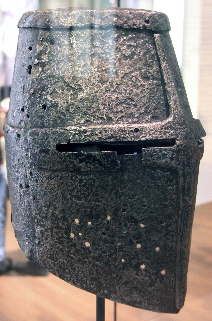
The Crusades figured largely in my study of medieval warfare, and so it’s no surprise that the one helmet from the time that should be included here is the medieval ‘Great Helm’.
This cylindrical helmet would have been worn over a chain mail headpiece, or coif, and was the standard for most knights going on Crusade to the Holy Land. Designs by way of the puncture holes for breathing varied, but they were all big with narrow eye slits and cross-like seems on the face.
I really like the look of this helmet, but I can imagine that in the heat of Palestine, it would have felt like being in an oven. Furthermore, because the ears were covered, and because of the box-like structure of the Great Helm, the echo inside must have been insane in the thick of battle.
When I see this helmet, I also tend to think of Monty Python and the Search for the Holy Grail. ‘None shall pass!’
The Waning of the Middle Ages
#4 – Gothic Armour
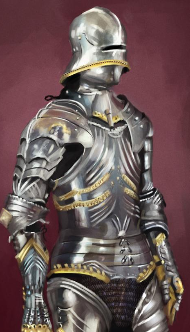
Some of the most complete and beautiful armour ever comes from the late middle ages. Late medieval armour was, in large part, a reaction to new weapons technology, namely firearms.
This was really the last hurrah for full body armour and helmets that matched beauty with defensive intent. We know it as Gothic armour, and there are plenty of well-preserved examples in museums and castles around the world where you can get up close and personal with it.
There are many styles, but they all share one thing in common: they seek to encase the wearer as much as possible to protect against sword, mace, axe, arrow, and of course firearm shots.
Early firearms were notoriously inaccurate, but knights would have been extremely vulnerable when charging into the spray from a bunch of arm cannons. The English longbows at Agincourt and Crécy destroyed the French knights, and this just took things one unfortunate step further.
The Gothic age of helmets and armour in general is a bit of a swan song.
Warfare had changed and the sight of fully armed knights tilting on battlefields such as Bosworth was soon to become a thing of the past, a thing of romance. Perhaps it is fitting that this was some of the most beautiful, functional armour all rolled into one. It was indeed the end of an age, and well-deserving of number four on my list.
Ghost Warriors
#3 – Late Roman Cavalry Helmets
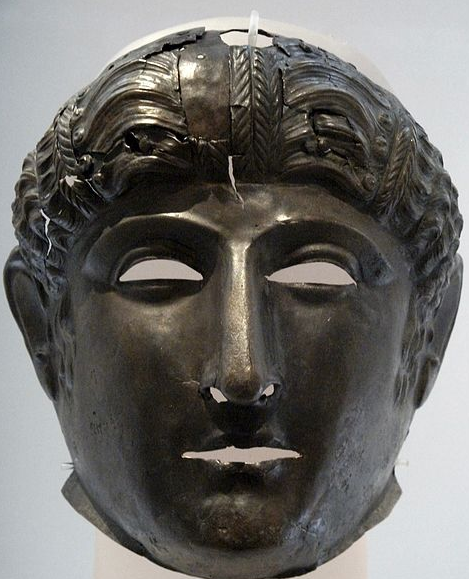
Now we come to it – the top three.
Whereas the men of the Legions had solid functional helmets when they went into battle, the cavalry alae of the Empire went in for something a bit more dashing and terrifying.
There is a lot of differentiation among the auxiliary units attached to the Legions because most of them were not Roman, and brought their own cultural style to the mix.
However, my favourite cavalry helmets are those with masks attached. They’re ornate on top, often with mythological scenes or beasts, and then have a mask of the same metal protecting the wearer but also striking fear into the enemies they were riding down.
There is some debate as to whether or not the actual masks were used only for demonstrations or parade, that they were perhaps removed for actual battle. But it’s not unlikely that they were indeed worn into battle. After all, some medieval helmets, as we shall see, provided much less visibility than a Roman cavalry mask.
These elite cavalry troops would have seemed like shades or furies as they rode into the fray, swinging a spatha and holding a howling draco standard. My solid number 3!
Men of the Legions
#2 – Roman Imperial Gallic Helmet
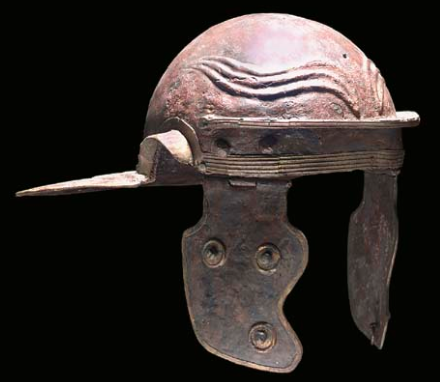
The Romans knew their warfare and their weapons. They also knew how to adapt, and how to adopt when they saw a good thing.
By far, my favourite Roman helmet has to be the Imperial Gallic helmet. If you look closely at the design, it makes perfect sense. They thought of everything – good vision and hearing for the legionary, protection for the back of the neck from downward slashes by those Celts, a visor in the front for the same thing, and massive cheek pieces that protected the side of the face without hindering vision.
This was a warrior’s helmet, and it was worn by tribunes, centurions, optios, and regular troops. A crest could also be attached depending on the rank of the person wearing it. But regular legionaries wore it without decoration and just went at it with the enemy in front of them. This is my pick for most utilitarian! It could easily take number one, but…
Grace in the Golden Age of Greece
#1 – The Corinthian Helmet
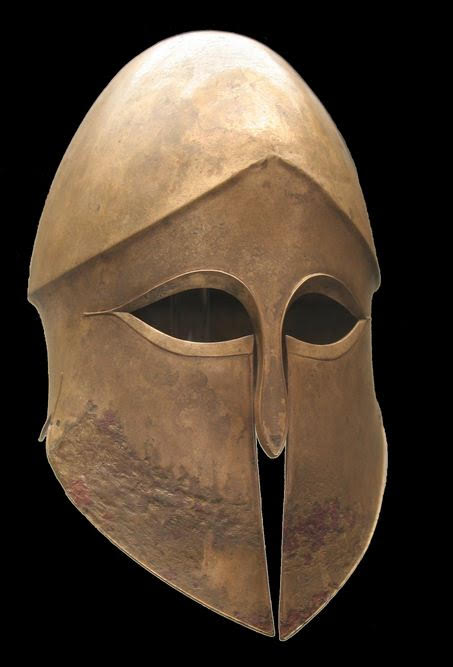
…I’m giving in to beauty.
When it comes to ancient Greece, the helmet that most people imagine is the Corinthian helmet. To me, this is a supremely beautiful helmet, my favourite for looks. It was used for several centuries, sometimes with a crest, sometimes without. These were made of bronze and would have been great at deflecting, spear thrusts, sword swings, and whizzing arrows.
I’ve tried on this helmet at re-enactor fairs and I must say that it’s very comfortable. Vision is decent, and it does indeed rest easily on the top of the head when not sweating it out in the shield wall. Hey, if it’s good enough for the goddess Athena, it’s good enough for me!
The one downside of the Corinthian helmet is that it would have been difficult to hear everything that was going on because there were no holes for the ears. Also, in the Mediterranean heat during the summer campaign season, it would have been hot!
But I still love the Corinthian helmet. For me, this is #1!
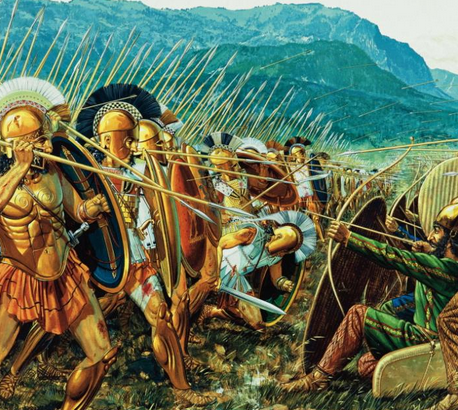
300 Spartans at Thermopylae – by Peter Connolly
This could easily have been a much longer list. It was harder than I expected (but oh, so much fun!) to pick just ten. They are unique, utilitarian, and beautiful in their own ways, and so deserving of a place on the list, in my humble opinion.
I’ve always felt very strongly that the invention of gun powder was a low point in human and military history. It meant that any coward could pick up a gun and, from a distance, take down the most skilled, well-trained warrior without breaking a sweat. It meant that the scale of casualties would increase, and that is something we feel painfully to this day.
A lot of people might disagree with that. They might say that guns are the great leveller.
But somehow, in an age of cold black steel and bullets, I don’t really think we’ll hear about heroes like Hector or Achilles meeting face to face. Alexander won’t be charging King Porus’ elephant on Bucephalas any time soon. The Spartan shield wall is lost to history and the lists of medieval Europe are long silent but for a few scattered bands of Renaissance Festival enthusiasts.
But the art of war does remain, and it serves as a reminder of the past and the reasons for it.
Next time you are at a replica shop, re-enactor fair, or Renaissance festival, be sure to slip an ancient or medieval helmet replica over your head. You’ll be taking one step closer to understanding and feeling the past.
Thank you for reading.
What does your top 10 list look like? Do you have a favourite?
Let us know in the comments below…















This was a fascinating post, Adam. It was any wonder how the Medieval knights were able to move in all that armour! The weight of it must have been extraordinary. Though the ancient soldiers’ armour wasn’t light either. I saw amazing helmets at Olympia in the museum which featured the Corinthian helmet. Their heads were small which surprised me. When reading about Achilles, Hektor, Agamemnon etc, you think of them as giants but they weren’t.
Thank you for sharing 😀
cheers
Luciana
Glad you liked this one, Luciana. I love the cabinet of helmets at Olympia. I’ve seen it a couple of times and never get tired of it. Might again this summer! The helmets may have been smallish, but I’m sure they were pretty heavy and hot in a Mediterranean summer. The boar’s tusk helmet looks as though it was bigger. I’ll have to check that out at the Nafplio museum (I think it’s there). Thanks for your comments, Luciana!
The Roman Imperial Gallic helmet looks an awful lot like the the Illyrien helmets
Yes they do. Very similar. The Romans knew a good thing when they saw it, and copied accordingly! Thanks for your comment, Dave.
Hey.
Really interesting stuff to read about . I was wondering if you knew anything about why the Protected their nose in some of the helmets? Was there a special reason or just decorations?
– Elli from Norway
Thanks for your comment, Elli. The nose protection definitely was not just for decoration. In a battle where swords and spears were used in close quarters, with lots of downward slashes, a nose guard could stop or slow a swinging blade from cutting into a warrior’s face. It’s nice to keep one’s nose 😉
I myself like the Norse helmets, but these were good choices, and I see why you’d choose those over the Norse one. I mean, the only reason I like the Norse helmet is, well, because Vikings.
Cheers for your comment, John! I agree that Vikings are just plain and brutal awesome! 😉
What do you think about Skanderbeg Helmet?
https://en.wikipedia.org/wiki/Arms_of_Skanderbeg
I don’t know much about the Skanderbeg weapons find, but from the little I have read, they are fascinating, especially as they are tied to such a famous character of Albanian history. The sword is supposed to be made of Damascus steel and looks very heavy – definitely a slashing weapon and not for thrusting. As for the helmet, it looks very impressive, but I have to wonder how practical it was for protection. It looks like it would have been very top-heavy. Also, it does not seem to have had any form of neck protection. The man who would have worn it must have been huge, strong, and very confident! The helmet would have added to his perceived threat. Thanks for your comment! 🙂
I found an old iron statue that has a ancient warrior portrayed. It is missing it sword so I am trying to identify an expert that may know who this warrior is, and culture, background etc., so I can identify what the sword may have looked like. I would like to re-create a sword for the statue that may be accurate. Thanks, Joe
Oh, I can send a picture of the statue.
Hi Joe! Sounds like a fascinating find! Did you find it metal detecting? We’re happy to take a look at it. Send us an email through the ‘Contact Us’ page of the website and we’ll get back to you by email. Another thought is that if you have a local museum near you, you could go in there to show the artifact to one of the curators to get their opinion. Local museums are a wonderful resource! Look forward to hearing from you. Cheers!